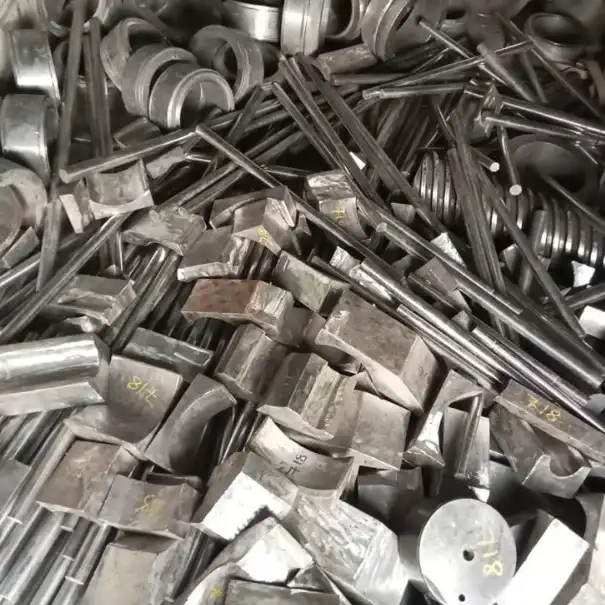As of mid-August 2025, ordinary Inconel scrap typically trades in a broad range from roughly $0.5 to $6.00 per pound at scrap yards, depending on alloy grade, contamination, form, and local nickel fundamentals — while mill/stock material (new bars, plate, bar) sells for a much higher premium (commonly $20–$50+/lb). If you are selling Inconel scrap, expect wide variance: clean, segregated, certified high-grade chips or turnings with assay can fetch multiple dollars per pound; mixed or contaminated pieces may only get pocket change.
What is “Inconel”?
Inconel is a family of nickel-based, corrosion- and heat-resistant superalloys originally developed for high-temperature service. The trade name “Inconel” covers several UNS/AMS alloys such as Inconel 625 (UNS N06625) and Inconel 718 (UNS N07718) among others. These alloys contain high nickel content (often 40–70%+ by weight) plus chromium, molybdenum, niobium (columbium), and other alloying elements that give strength at temperature and corrosion resistance. The exact chemistry and the presence of alloying elements are the single biggest reason some alloy scrap is worth noticeably more than other nickel-bearing scrap.
Why this matters for scrap value: nickel is the primary value component; other elements (e.g., molybdenum, niobium) and the absence/presence of contaminants (paint, fasteners, stainless steel mix) alter the recycle yield and hence the price offered.
How scrap prices are determined
Scrap pricing for Inconel is not a single published exchange figure. It is the result of several linked components:
-
Base metal price (nickel): scrap buyers index alloy scrap offers to some reference of nickel price (LME, local spot, or negotiated contract). Changes in nickel commodity prices are the dominant influence.
-
Alloy grade: high-nickel alloys with valuable alloying elements (625, 718, 725, X-750, etc.) command higher pay.
-
Chemical purity and contamination: cuttings mixed with oils, coatings, lead, stainless or ferrous attachments reduce value.
-
Form and size: clean shavings/turnings (if dried and free of tramp metals) fetch higher prices; large clean parts sometimes attract a premium because they’re easier to re-melting.
-
Assay and traceability: seller-provided assay or chain-of-custody that proves alloy and absence of restricted elements increases buyer confidence and price.
-
Regional demand and logistics: local demand, furnace technology, shipping costs and scrap yard inventory strongly affect the cash price offered.
-
Market friction: refining and recovery costs: recyclers subtract processing costs and expected recovery efficiency from theoretical metal content value (ISRI specification and buyer agreements define categories).
Bottom line: think of the scrap quote as (metal content value based on nickel price) − (processing/refining and contamination discounts) ± local logistics premiums.
Typical price ranges
Below is an illustrative pricing snapshot for August 2025 based on market quotes, scrap yard listings, and mill prices. These are example ranges and will vary by location and contract.
Typical Inconel price bands (Aug 2025, representative examples)
| Category | Typical price (USD per lb) | Notes / example sources |
|---|---|---|
| Mixed, contaminated Inconel pieces | $0.50 – $1.50 / lb | Lower end of scrap yards; heavy contamination or mixed with other metals reduces price. |
| Clean, segregated Inconel scrap (sorted by alloy) | $1.50 – $4.00 / lb | Clean alloy 625 or 718 turnings/chips with minimal contamination. |
| High-value, certified alloy bundles / swarf with assay | $3.50 – $6.00+ / lb | Certified, high-nickel content, dried and free of tramp materials; buyer-refined. |
| Mill stock (new bar/plate/rod, small quantity) | $20 – $50+ / lb | New product price; not “scrap” — includes fabrication, mill margins. |
| Pure nickel metal (for reference) | ~$6.8 / lb (LME reference ≈ $14,900 / metric ton ≈ $6.76/lb) | Gives a theoretical floor for nickel content value; alloy scrap will be priced relative to this after recovery and refining costs. |
Notes on the table: the “pure nickel metal” conversion uses LME figures and converts metric-tonne quotations into USD per pound; recyclers treat that number as an input, not a direct payable amount. Because Inconel contains additional costly alloying elements, very clean Inconel scrap can exceed the pure-nickel equivalent on a per-pound basis once refiners credit for those elements — but processors will deduct recovery and contamination costs.

Real price examples seen in the market
-
Local scrap yard listings: some public scrap lists show $0.75/lb (30-day average $1.88/lb) for certain Inconel categories, illustrating very low end of the retail scrap channel.
-
Specialized buyers / reclaimers: other buyers advertise receiving $2.00–$2.75/lb for certain Inconel grades (e.g., 718) depending on form.
-
Mill prices vs scrap: distributors and mills list Inconel mill product at $20–$50+/lb for new bar/plate (not scrap). Sellers sometimes confuse mill price and scrap price; treat them separately.
Why those numbers diverge: public scrap listings are often retail, small-quantity rates aimed at walk-in sellers. Commercial, high-volume contract deals between industrial sellers and refiners will use assay-backed pricing referenced to nickel markets and yield much better outcomes.
How recyclers classify and pay for Inconel scrap
Industry standard specifications (ISRI) and buyer practices define categories such as “nickel-bearing scrap,” and specify minimum nickel recoverable percentage, allowable contamination, and physical description. Buyers typically:
-
Visually inspect and classify the lot (alloy family, presence of other metals).
-
Weigh the lot (gross weight) and may deduct packaging or tare weight.
-
Ask for assays (certified chemical analysis) for higher value lots or deduct an expected recovery percentage when no assay is available.
-
Apply discounts for oil, coatings, chlorides, or mixed grades.
-
Offer a base price (often tied to an agreed nickel reference index) and adjust after assay and final reconciliation.
Important: ISRI scrap specifications are commonly referenced by U.S. and international recyclers; sellers should learn the categories that match their material to avoid misclassification discounts.
How to prepare Inconel scrap to maximize price
Practical, cost-effective steps that commonly raise net proceeds:
-
Segregate by alloy and form: keep 625, 718, and other families separate if possible. Buyers pay more for homogeneous lots.
-
Remove gross contaminants: bolts, steel plates, embedded ferrous parts — if removal costs are low, do it.
-
Dry the material: oils and trapped refrigerants reduce offers and may be illegal to ship.
-
Provide traceability: purchase orders, mill certificates, or heat numbers raise buyer confidence and price.
-
Ask for an assay for large or valuable loads — a small lab analysis that declares nickel, molybdenum, niobium contents can add significant value.
-
Consider direct sale to specialized reclaimers for large volumes rather than local scrap yards; reclaimers routinely pay more but require logistics and paperwork.
Pricing example (worked calculation)
Scenario: You have 1,000 lb of clean, segregated Inconel 625 turnings. A buyer references LME nickel at $14,900/metric tonne (~$6.76/lb nickel) and offers a formula: payable = (nickel_equivalent_value × 0.70) after alloy and recovery adjustment. Inconel 625 nominally contains ~58–63% Ni (varies by chemistry). Assume recovered nickel equivalent = 60% by weight.
Step-by-step (digit-by-digit):
-
Nickel value per pound = $14,900 / 2204.62262184878 = $6.76 per lb (LME reference).
-
The theoretical nickel content value per lb of alloy = 0.60 × $6.76 = $4.06 per lb.
-
Apply payer’s recovery factor (70%): payable = $4.06 × 0.70 = $2.84 per lb.
-
For 1,000 lb: gross payable ≈ $2,838.58. Buyer may then deduct assay verification, freight, and processing fees, but this shows the mechanism.
This arithmetic highlights why clean alloy with assay can reach multiple dollars per pound, while mixed/dirty material falls to fractions of a dollar.
Documentation, legal and environmental considerations
-
Export controls & sanctions: certain alloys or shipments to specific countries may require compliance checks. Know the end-use and consignee.
-
Hazardous contaminants: oils, PCBs, refrigerants and asbestos (rare in Inconel) create disposal liabilities. Buyers will discount or refuse.
-
Data privacy & IP: removed parts from aerospace or defense platforms may have legal constraints; many buyers will refuse such material without proper clearance.
-
Waste and emissions: reclaiming alloys involves melting/refining; ensure buyers follow environmental permits — sellers can ask for buyer compliance confirmation.
Selling channels and what to expect
-
Local scrap yards (walk-in): fast cash, low price, better for small loads or contaminated material.
-
Specialized alloy reclaimers / smelters: better prices for large, clean, certified lots; may require longer payment terms and transport coordination.
-
Brokers / traders: useful when you have large volumes and prefer the broker to find the best furnace; broker fees apply.
-
Distributors (for mill stock): if you have new or nearly new material, sell as mill stock — you’ll get a fraction of distributor mill price but often higher than scrap rates.
Market outlook (how nickel markets will steer scrap)
Nickel fundamentals (electric-vehicle demand, Indonesian production, supply disruptions) set a backdrop. In 2025 nickel has shown volatility and periodic rallies; when nickel strengthens, Inconel scrap bids generally follow higher after accounting for recovery margins. Conversely, when nickel weakens, scrap offers compress — but the presence of other alloying elements (molybdenum, niobium) can cushion some downside. Monitor LME and major reporting agencies for trend signals.
Frequently Asked Questions (FAQs)
1. What is the difference between Inconel mill price and Inconel scrap price?
Mill price is the market for new, certified bars/plate (manufactured product) and typically runs many times higher than scrap. Scrap price is what recyclers pay for end-of-life or manufacturing waste material and is tied to metal content and recovery costs.
2. How can I tell which Inconel alloy I have?
Look for mill certificates, heat numbers, and markings. If unavailable, request a chemical assay (lab analysis) or XRF scan from a metal tester. Buyers often require assay for higher pay.
3. Do scrap yards pay for Inconel turnings/chips?
Yes — but cleanliness matters. Dried, unmixed turnings fetch better offers than oily, mixed swarf due to drying and contamination removal costs.
4. Is Inconel scrap worth more than stainless steel scrap?
Often yes on a per-pound basis because of high nickel content and additional alloy elements, but exceptions exist depending on contamination, form, and local market demand.
5. How does nickel price affect my scrap payment?
Most scrap offers are indexed to nickel reference prices (LME or local index). When nickel rises, expected scrap payouts rise; when it falls, payouts fall.
6. Should I get my material assayed before selling?
If you have a large quantity or suspect high alloy content, yes — assays often increase the net sale price by proving value and avoiding conservative discounts.
7. What paperwork will buyers ask for?
Common requests: material description, weight ticket, proof of origin, heat number/cert (if available), and assays for premium pricing. Some reclaimers will also ask for environmental declarations.
8. Can I ship small quantities to reclaimers?
Yes, but logistics and minimums vary. For small lots, local yards often are more practical even if prices are lower.
9. Are there impurities that completely ruin the lot’s value?
Yes — lead, significant ferrous inclusions, radioactive contamination, or segregated hazardous coatings can make a lot unsellable or require disposal.
10. Where can I find daily or weekly Inconel scrap references?
There is no single public exchange for Inconel scrap; monitor specialized scrap aggregators, rebuilders’ price lists, and consult buyers for quotes. Also keep an eye on base nickel prices at LME and industry price reporting services.
Practical checklist before you sell
-
Segregate alloys and forms.
-
Dry and remove organic contaminants.
-
Collect mill certs / heat numbers.
-
Weigh accurately (certified scale).
-
Request assays for large/high-value loads.
-
Shop quotes between at least two reclaimers.
-
Understand payment terms (cash, wire, delayed reconciliation).
Closing summary
Inconel scrap is valuable but complicated. The best proceeds flow to sellers who can present clean, segregated, certified material, match buyers who specialize in nickel-based alloys, and understand how offers are indexed to nickel markets and adjusted for recovery and contamination. Small, mixed, or contaminated lots will usually land at the lower end of the scrap spectrum, while large, certified deliveries can approach or exceed pure-nickel equivalents after refiners credit other alloying elements.

